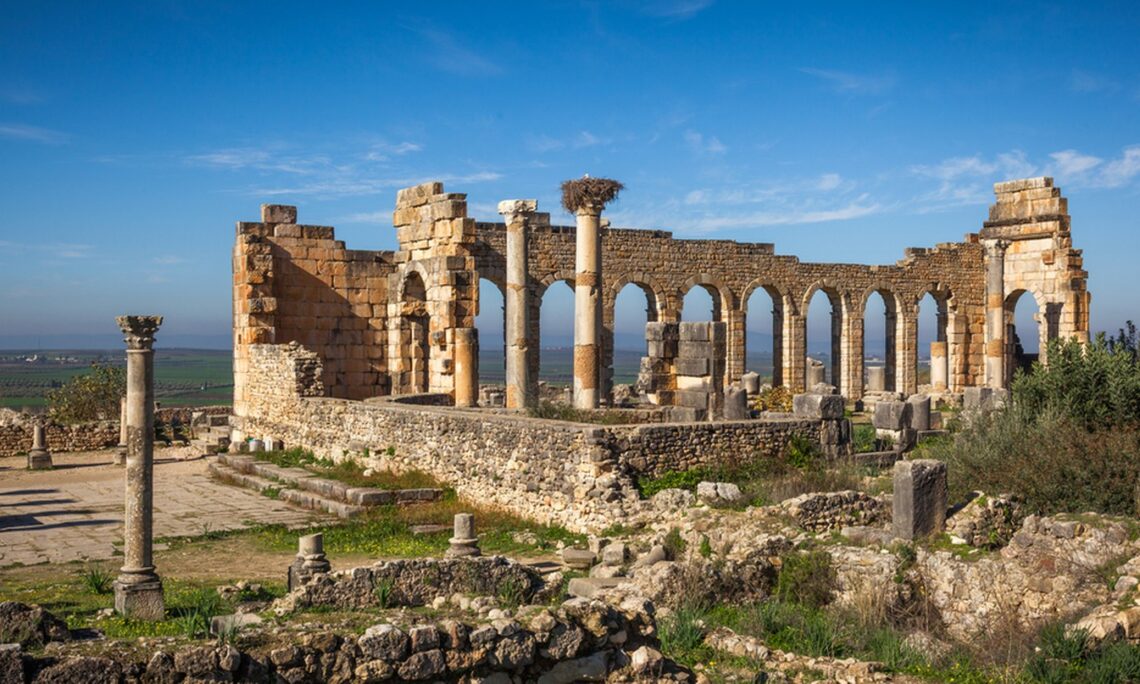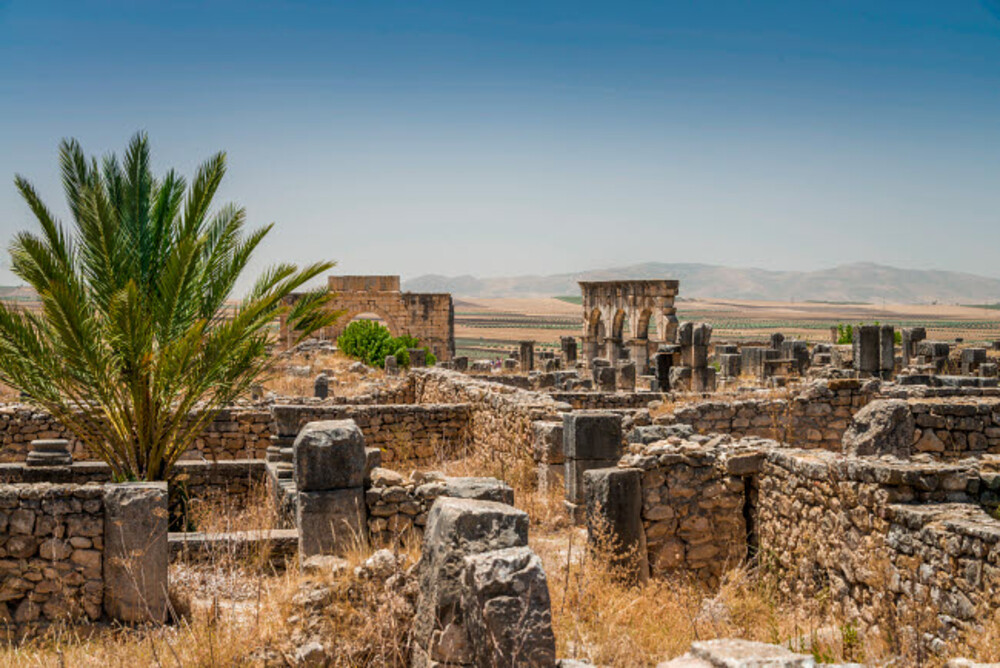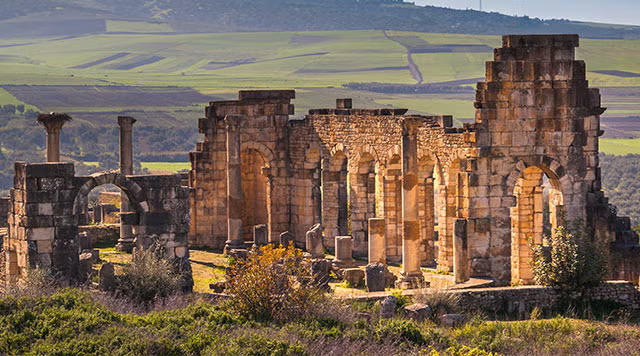
Volubilis: The ancient city frozen in time
Introduction
In the heart of Morocco, the ancient city of Volubilis stands as a silent witness to the grandeur of Roman civilization. Once a bustling center of trade and governance, its ruins offer a unique glimpse into the past. This introductory section will explore Volubilis’s journey through time, emphasizing its historical significance and the charm that captivates visitors from around the world, drawing them into its time-frozen streets.
The Rise of Volubilis
Volubilis, originally a Berber settlement, flourished significantly under Roman rule beginning in the first century BC. It became an important outpost of the Roman Empire, serving as a key administrative and economic center. This part of the article explores how Volubilis evolved into a thriving city, pivotal in ancient trade routes connecting Africa and Europe, showcasing its role in the larger context of ancient Mediterranean trade networks.
The Roman Influence


Roman influence brought profound changes to Volubilis, transforming it with grand architecture and urban planning that spoke of the empire’s greatness. Grand public buildings, streets lined with columns, and homes decorated with elaborate mosaics were built, signifying the city’s importance in the Roman Empire. This section will delve into the architectural and cultural impacts of Roman rule in North Africa, evident in the sophisticated city layout and the remains that attract archaeologists and historians alike.
Decline and Rediscovery
After the fall of the Roman Empire, Volubilis experienced a slow decline, eventually being abandoned after the 11th century. Rediscovered in the 19th century, significant archaeological excavations began in the 20th century, uncovering much of its hidden glory. This section will discuss the city’s fall into obscurity, its rediscovery, and the subsequent archaeological efforts that have brought to light the rich history of this magnificent site.
Key Archaeological Discoveries
Archaeological digs at Volubilis have uncovered numerous treasures that offer insight into the daily life and governance of its inhabitants. Notable discoveries such as the Triumphal Arch, the Basilica, and the Capitoline Temple reveal the city’s architectural grandeur and its central role in administrative and religious activities. This section will highlight these key findings, illustrating the city’s historical and architectural significance.
The Triumphal Arch

The Triumphal Arch, erected to honor Emperor Caracalla, serves as a powerful symbol of Roman victory and imperial power. Standing majestically at the entrance of the city, it once welcomed travelers and traders, signifying the city’s importance within the Roman Empire. This part of the article explores the arch’s historical context and its significance as a monument celebrating Roman architecture and engineering prowess.
The Basilica and the Capitoline Temple
The Basilica and the Capitoline Temple were central to the civic and religious life in Volubilis. The Basilica served as a courtroom and a venue for business transactions, while the Capitoline Temple, dedicated to the triad of Jupiter, Juno, and Minerva, was the religious heart of the city. This section discusses their architectural features and the roles they played in blending governance with spiritual observance.
Mosaic Art and Daily Life Insights
The mosaics of Volubilis are among the best-preserved in the world, depicting scenes from mythology, daily life, and the natural world, providing invaluable insights into the cultural and aesthetic values of the time. This section will explore how these mosaics serve as a window into the past, offering clues about the daily activities, beliefs, and the artistic excellence of the people who once lived there.
Conservation Efforts
Preservation efforts at Volubilis have been ongoing to protect and maintain its structures for future generations. Challenges such as environmental wear and the need for sustainable tourism are being addressed through international and local cooperation. This part of the article highlights the strategies employed in conserving this UNESCO World Heritage site, emphasizing the importance of safeguarding our global heritage.
Volubilis as a Tourist Destination
Today, Volubilis is not only an archaeological treasure but also a major tourist attraction in Morocco. Visitors are drawn to its ancient streets, monumental ruins, and the story of a city that once connected continents. This section discusses how Volubilis fits into Morocco’s tourism landscape, contributing to cultural understanding and economic development through heritage tourism.
Visiting Volubilis: Practical Tips
Planning a visit to Volubilis requires some practical considerations to enhance the experience. This section offers tips on travel arrangements, the best times to visit to avoid crowds and extreme weather, and what to bring on a trip to an archaeological site, ensuring a comfortable and enlightening visit.
Best Time to Visit
The best time to visit Volubilis is during the spring and autumn months when the weather is mild and the natural surroundings are at their most beautiful. This part provides detailed advice on planning a visit during these optimal times, offering the best experience for exploring the extensive ruins comfortably.
Guided Tours and Self-Exploration
Visitors to Volubilis can choose between guided tours, which offer expert insights and historical context, or exploring the site independently. This section compares the benefits of each option, helping travelers decide how to best experience Volubilis based on their personal interests and style of exploration.
Influence on Moroccan Culture
Volubilis has played a significant role in shaping Moroccan cultural identity, its history and art influencing modern Moroccan arts, architecture, and civic life. This section explores the legacy of Volubilis and how it continues to influence contemporary Moroccan culture, bridging past and present.
Volubilis in Popular Media
Volubilis has captured the imagination of filmmakers, writers, and artists, appearing in various forms of media. This part of the article discusses its portrayals in films, literature, and other media, showcasing the city’s enduring appeal and its impact on popular culture.
The Lasting Legacy of Volubilis
In conclusion, Volubilis stands as a testament to the complexity and grandeur of ancient civilizations. Its enduring legacy offers valuable lessons in history, culture, and conservation, making it a site of global significance. This section reflects on what makes Volubilis a unique and unforgettable part of Morocco’s heritage, captivating all who walk its ancient paths.
FAQs
- What is the best way to get to Volubilis?
- The best way to reach Volubilis is by car from nearby cities like Meknes, which is about a 30-minute drive away. There are also local tour operators that offer trips to the site.
- Are there any entry fees for Volubilis?
- Yes, there is a small entry fee for visiting Volubilis. The fee helps fund the preservation efforts of the site.
- What are the must-see attractions at Volubilis?
- Key attractions include the Triumphal Arch, the House of Orpheus, and its stunning mosaics, and the Basilica. Don’t miss the panoramic views from the top of the hill.
- How much time is needed to explore Volubilis thoroughly?
- To thoroughly explore Volubilis, plan to spend at least 2 to 3 hours. This allows you to see all major ruins and take guided tours if desired.
- Can Volubilis be accessed by wheelchair?
- Parts of Volubilis are accessible by wheelchair, but some areas may be challenging due to uneven terrain. It’s advisable to check with the site management for the latest accessibility options.
All Categories
- Actividades en Marruecos
- Adventure
- Aventura
- blog
- blog
- Camping salvaje
- City Tours
- country tours
- Desert tours
- Estilo de vida
- Excursiones de un día a Marrakech
- Life Style
- Marrakech Day Trips
- Morocco activities
- Morocoo
- Rutas por el desierto
- Sin categorizar
- viajes por el país
- Visitas por la ciudad
- Wild Camping


